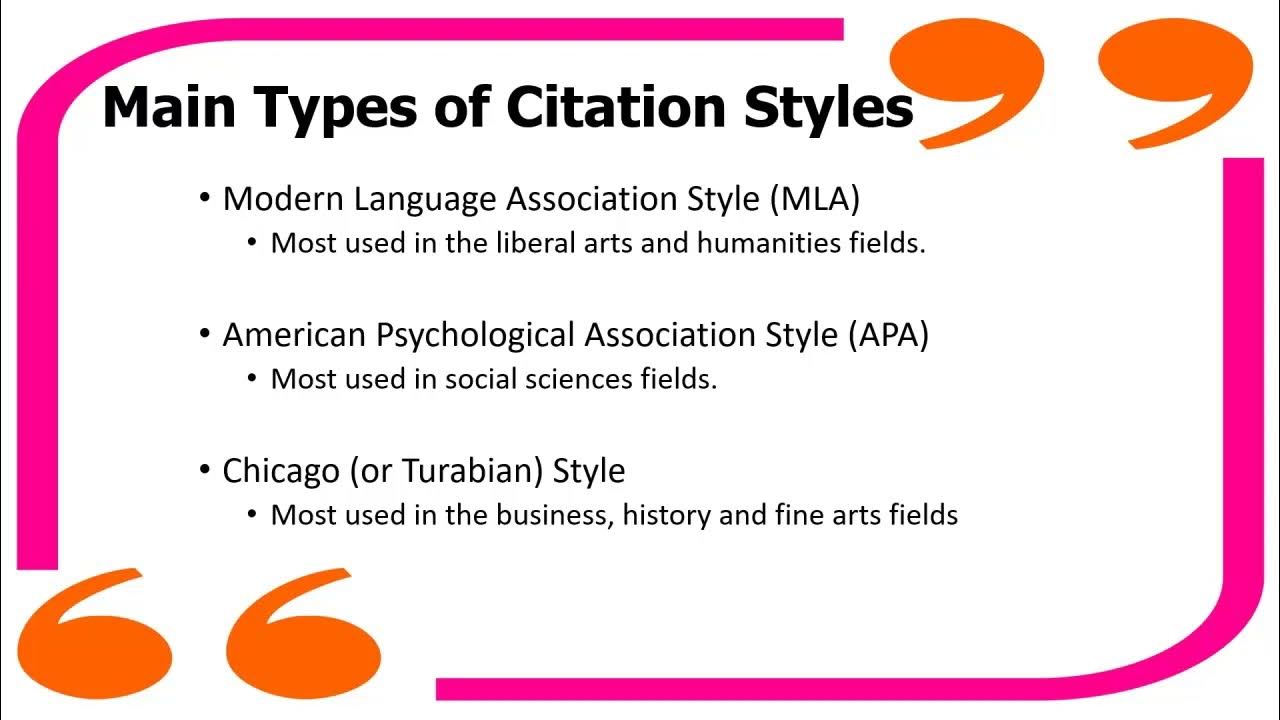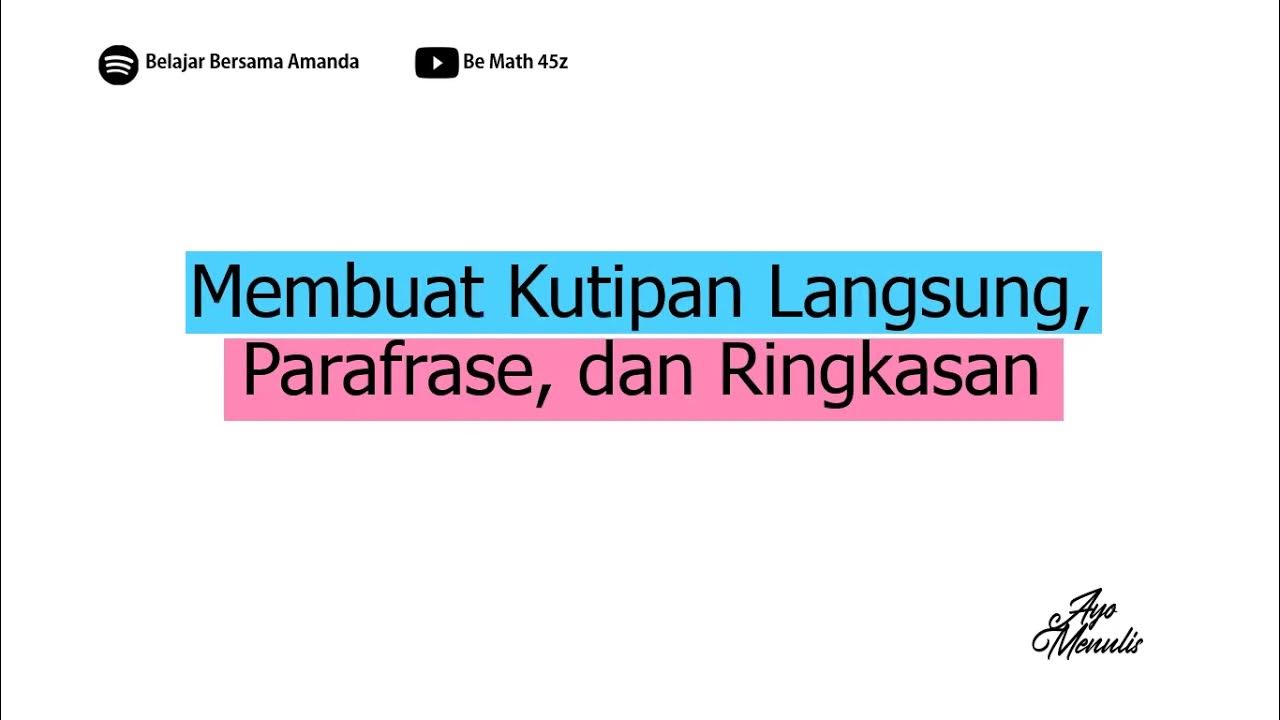Video Pembelajaran Bahasa Indonesia Materi Notasi Ilmiah
Summary
TLDRThis video provides a comprehensive guide to scientific notation and citation methods in academic writing. It explains the importance of direct and indirect quotations, including how to format them correctly. The video covers different types of citations such as footnotes, body notes, and endnotes, and discusses the rules for writing a bibliography. Key concepts such as paraphrasing, summarizing, and using citation styles are explored to help students properly reference sources in their research. The tutorial is aimed at students in higher education, offering practical advice for writing scholarly papers.
Takeaways
- 😀 Notation refers to the method of using symbols or signs to represent information, particularly in scientific writing to cite sources.
- 😀 A citation is a borrowed idea or thought from a book, article, or another author's work, and can be categorized as direct or indirect.
- 😀 Direct quotes are copied word-for-word from the original source, with short quotes being up to five lines and long quotes being more than five lines.
- 😀 Short direct quotes are integrated into the text, while long quotes are written separately and indented.
- 😀 Indirect citations involve paraphrasing or summarizing another author's work while preserving the core idea but changing the structure or wording.
- 😀 Footnotes are used to provide additional reference information at the bottom of the page, often including the author's name, book title, and other citation details.
- 😀 Footnotes are numbered sequentially throughout the document, and the citation format includes the author's name, book title, publisher, and year.
- 😀 Ibidem (ibid.) is used to reference the same source as the previous citation, while Op. cit. refers to the same source but with a different page number.
- 😀 Body notes provide additional context or explanations following a quote, typically in parentheses, citing the author's name, publication year, and page number.
- 😀 A bibliography is a list of all sources referenced in a document, presented in alphabetical order, and includes full citation details such as book titles, authors, publishers, and page numbers.
Q & A
What is the definition of scientific notation based on the script?
-Scientific notation is a method of writing or representing scientific works in which sources or references are cited in a structured manner to maintain academic integrity.
What is a direct quotation, and how is it different from an indirect quotation?
-A direct quotation is a verbatim excerpt from a source, copied exactly as it appears without modification. An indirect quotation, on the other hand, is a paraphrase or summary of someone else's ideas, rephrased using the writer's own language while maintaining the original meaning.
What are the two types of direct quotations mentioned in the script?
-The two types of direct quotations are short direct quotations (up to five lines) and long direct quotations (more than five lines).
How should a short direct quotation be formatted?
-A short direct quotation should be incorporated directly into the text, enclosed in quotation marks, and aligned with the body of the text.
What are the formatting guidelines for a long direct quotation?
-A long direct quotation should be separated from the main text, written in a single-spaced block format, and indented from both sides. The source should include the author's name, year of publication, and page number, if necessary.
What is the purpose of using an indirect quotation?
-Indirect quotations are used to restate or summarize an author's ideas in the writer's own words, which can help clarify or simplify the original text while still conveying the key message or concept.
What is a footnote, and how is it used in academic writing?
-A footnote is a note placed at the bottom of a page that provides additional information about a citation, such as the source of a quote or reference. It helps clarify or give more context without interrupting the main text.
What does the term 'ibid.' refer to in citation practices?
-'Ibid.' is an abbreviation for 'ibidem,' used in citations to refer to a source that was previously cited, particularly when the citation is from the same source and page as the one immediately preceding it.
What is a bibliography, and why is it important in academic writing?
-A bibliography is a list of all sources referenced in a piece of academic writing, typically located at the end of the document. It ensures that proper credit is given to authors and allows readers to access the same sources.
How is a reference in a bibliography for a single author formatted?
-For a single author, the reference is formatted by listing the author's last name, first name, year of publication, title of the work, place of publication, and the name of the publisher.
Outlines

Esta sección está disponible solo para usuarios con suscripción. Por favor, mejora tu plan para acceder a esta parte.
Mejorar ahoraMindmap

Esta sección está disponible solo para usuarios con suscripción. Por favor, mejora tu plan para acceder a esta parte.
Mejorar ahoraKeywords

Esta sección está disponible solo para usuarios con suscripción. Por favor, mejora tu plan para acceder a esta parte.
Mejorar ahoraHighlights

Esta sección está disponible solo para usuarios con suscripción. Por favor, mejora tu plan para acceder a esta parte.
Mejorar ahoraTranscripts

Esta sección está disponible solo para usuarios con suscripción. Por favor, mejora tu plan para acceder a esta parte.
Mejorar ahoraVer Más Videos Relacionados

CARA MENGGUNAKAN ZOTERO DALAM PENGUTIPAN KARYA TULIS ILMIAH

Citation Basics (MLA, APA & Chicago)

Penulisan Judul dan Alur Latar Belakang untuk Publikasi Ilmiah dan Laporan Skripsi

Introdução à notação científica

Cara Mengutip untuk Menghindari Plagiat: Parafrase, Kutipan Langsung, dan Rangkuman

正しいコピペ(引用)の仕方・引用文献の書き方【レポート・卒論・論文の書き方 】
5.0 / 5 (0 votes)
